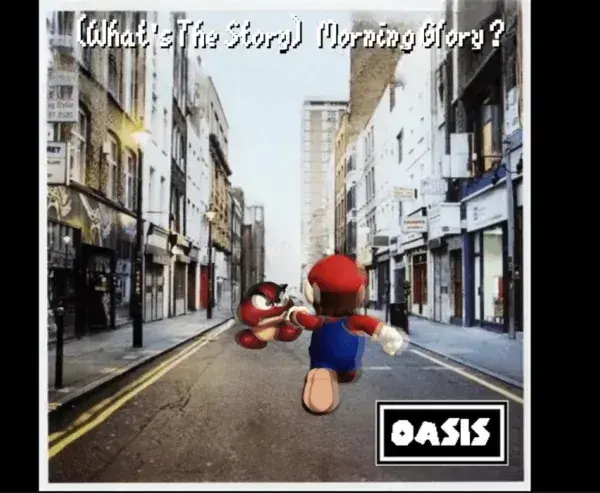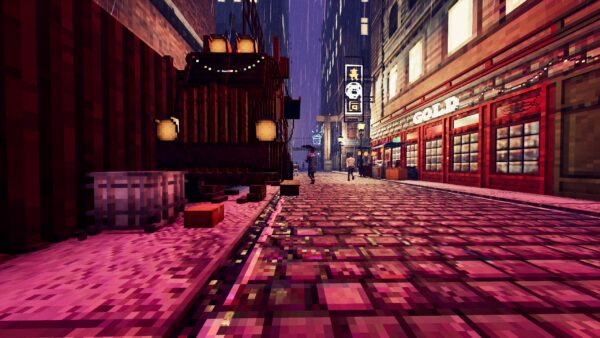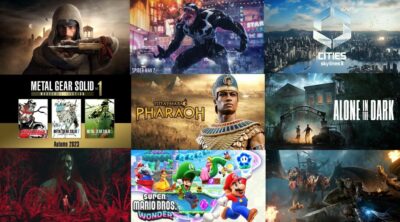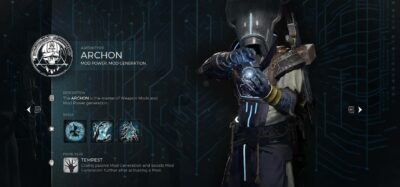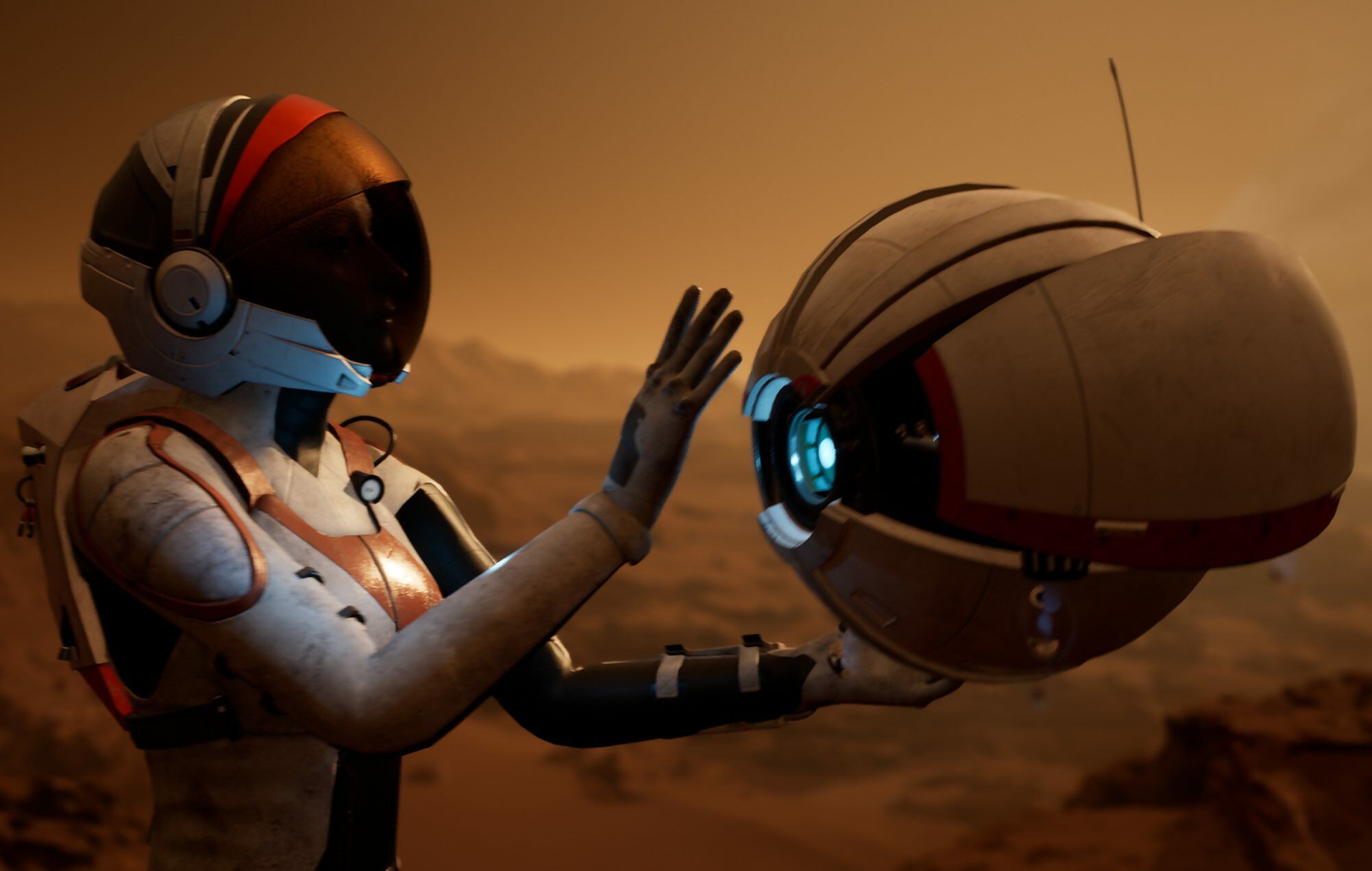
Deliver Us Mars sees developer KeokeN Interactive follow up its 2019 sci-fi hit with a high-stakes interstellar adventure. We caught up with the founders to find out more…
Science fiction stories often deal with big ideas and grand themes. That a small studio led by two Dutch brothers (who first started out drafting ideas in their kitchen using their sister’s whiteboard) could tell such a story on a relatively tight budget was something of a giant leap, then – one that thousands of people on Kickstarter clearly believed in, given they backed their project to the tune of €103,770 in 2016. Fast forward three years since KeokeN Interactive first launched Deliver Us The Moon, its modest yet poignant near-future story concerning one lonely astronaut’s mission to salvage resources needed to save a depleted Earth, and the team now has its sights set on something bigger.
With a new, fresh-faced protagonist to play as, comes a more personal mission to complete. Deliver Us Mars picks up the story roughly a decade on, when Kathy Johanson of the Zephyr space shuttle crew is in search of her missing father.
Finding out what happened to him as well as the ARK colonisation vessels stolen by the shadowy Outward organisation years earlier, however, involves traversing a totally different environment on Mars. To find out how KeokeN Interactive affectionately and realistically portrayed the eponymous red planet, we spoke to studio co-founders (and brothers) Koen and Paul Deetman…

The Zephyr shuttle crew are called to Mars after receiving a distress signal from ARK colony ships thought to have been lost. Kathy, however, also has a personal mission in mind.
In what ways has the team dynamic and size changed since those early days when you guys were first Kickstarting Deliver Us The Moon?
Koen Deetman: With a core team of ten on Deliver Us The Moon, we didn’t want to increase that significantly because we wanted to stay agile in a lot of ways – in time, budget, and team size. So let’s say the core team is around 30 or 40 people. That’s the total production team.
Paul Deetman: I think we’ve always loved blockbuster movies, but also games. And even back in the day, we were recording home videos like Star Wars and James Bond in our back garden, kind of cutting away VHS tapes and making it happen. Sound effects recorded with our little camcorder… I think that’s just resulted in us making this on a bigger level. So therefore, we started on the kitchen table. From there onwards, we started portraying these [larger] than life stories that we wanted to tell. Guerrilla was the only one in the Netherlands doing that. So we said, ‘Let’s try it’, and now we’re here.
What are some of the benefits of keeping the team small? Because I honestly think people just looking at Deliver Us Mars might assume that it’s something on a higher triple-A level…
KD: First of all, I think, in general, game development has become a lot easier thanks to massive engines that are globally distributed. Whereas, previously, these bigger studios needed to maintain engine teams and game development teams, so one was either playing or making the game and the other was fixing their engines – that is massively changing right now. But that’s more on a practical side. The people we have at KeokeN are very modest people that actually can do a lot more than just their role. So we don’t have a specialist in vegetation, for example, but that person would probably be someone who knows how to portray nice lighting, too.
PD: You hear horror stories about massive triple-A studios running with, like, 1,000 to 5,000 people with extreme budgets, [and] maybe not even being that efficient. We’re a young, versatile team that can pick up a lot of disciplines, while still keeping a work-life balance in place.

When Kathy arrives on Mars, her first priority is to find an oxygen source. Before long, though, she’s powering up mining colony resources – like this rover.
How has the new publishing relationship with Frontier enabled you to potentially accomplish things you maybe otherwise wouldn’t have been able to?
KD: So our ideas just go beyond craziness sometimes. Frontier absolutely has enabled us to reach these ambitions. In a lot of ways we stepped up from the first [game], having a very cool cast, a whole new protagonist played by a cool actor [Ellise Chappell] that has played in some Netflix series. And that’s something we previously couldn’t have done. We could only dream about it. But the fact that it opened up through working with Frontier? Yeah, it was amazing.
PD: We try to maximise the ambition that we have with the resources at our disposal. Frontier has helped us make that bigger step we were dreaming of. It helped us on every step so we could make a huge leap forwards in the way we tell these blockbuster stories.
What’s the appeal in leaning into a more grounded take on sci-fi, as opposed to something more fantastical?
KD: Well, our granddad was a telescope builder, and when we were very young, he showed us the Moon up-close with his own telescope. Then again, being fans of 2001: A Space Odyssey, Interstellar, and Gravity gave us the idea that there wasn’t too much [of it] around. Of course, sci-fi quickly jumps into lightsabers because you can tell a more fantasised, bigger story that could give a lot of character to the universe. But this time around, we like to keep it grounded. It’s also sometimes fighting against us, but it’s a very good challenge to make something engaging and grounded. Of course, not everything is grounded. We need to keep it playful in some ways. There was once a guy who said, ‘Oh, it’s not very grounded because it takes a lot longer to go to the Moon’. Now, of course, we could give you an eight-hour ride to the Moon’s surface, sure, but it should also be playable.
PD: I think it lends itself well here, especially because with the realistic graphics we’re going for, it makes sense to stay grounded, but then also the story needs to be a little bit more plausible on the reality side of things. There’s also so many fantasy sci-fi stories [already] – nothing very close to reality or very close to the future that may come. And we kind of wanted to intertwine what’s happening with our Earth right now with the story. It’s kind of like what Black Mirror does. What if this is the future? What are the pros and cons from that moment? That’s what we tried here as well.
Was having Mars as the setting for the sequel always guaranteed, or were there other planets you considered?
KD: We’ve seemed to hit at the right moment. The space agencies are ramping up and wanting to go to Mars, so it’s kind of evolved through that hype.
PD: It ties into your previous question. It’s a logical step forward that needs to [happen], and if we did go outside of our solar system, it probably wouldn’t really fit the timeline. You could make it work if you skip some timelines here and there. But it was more obvious to us that we needed to go to Mars in this one. And now, again, with SpaceX and Elon Musk going there, I think it’s actually a great fit; we are a little bit ahead of that, seeing what may come on Mars.

The version of Mars depicted in-game has been informed by real-life scientific study and research.
In what ways has the new Martian setting influenced or inspired new gameplay mechanics?
KD: What’s interesting about our game is that we don’t necessarily have any immediate violence that is acted out by the character herself. So if we want to create any conflict, resolution, or resolve, [nailing] the sense of danger is a tough one. In our previous game we had a lot of timers, and we weren’t too fond of those. So to enable players to feel a sense of danger, we thought, ‘How can we make people feel as if they’re traversing the landscape in a dangerous way?’ Not only by having oxygen, but maybe having to really hold on when you’re climbing these areas. Practically, there’s that sense of danger of holding on and trying to get to safety. It also immediately [conveys] the verticality of our game, not using only stairs or elevators, but also having the ability to navigate these human-made structures and have them be part of your progression. But yeah, you feel more a sense of adventure and danger while trying to get off a cliff or having that vertigo feeling.
PD: We really wanted to expand on what we did with Moon. All this stuff was there that people really liked, like the laser cutting and cutting things open. To expand on that sense of adventure, climbing was a logical way to see how can we make it even more of a ‘Tomb Raider in space’ adventure. Climbing was just the right step.
What sort of new puzzles can players expect to tackle, and how will they evolve as Deliver Us Mars goes on?
KD: In the first game, we learned a lot from the one-off [puzzles]. Not only were those expensive to create, though, but we now wanted something of a reproductive thing throughout the experience that players can also learn and take from. It gave the designers the ability to craft more interesting puzzles, yes, but also brain-teasers that players can think through. Most puzzles in Moon were straightforward, and most things were the same or were used the same. In this one we could have potentially increased the difficulty, but there’s also different solutions sometimes to go through the environments. That gives a bit more personality to the experience.
PD: Yeah, we try to onboard the player very playfully. Step by step you get more mechanics that eventually you need to use in these environments; environmental hazards are popping up in the puzzles that you need to do. Sometimes it’s a combination of having a bit of climbing, then you need to solve something until you reach the conclusion. So yes, we’ll ramp up the difficulty throughout the game. It’s a tutorial, but it’s done in a more playful way, woven into the narrative where you’re like, ‘Ah, it makes sense that we now get the pick-ups for the first time, and now we’ll learn a little bit how that movement is working’. Later on in the game, there’s more combinations between these moving elements – climbing and all these things.
Deliver Us Mars features more emphasis on character and story than the first game. Why did you decide to go down this route?
KD: Deliver Us The Moon was set up to be very grand in scale. It being our first game, we were bound to certain ways of developing. We, of course, would have loved to have an extensive cast in there; it wasn’t something possible yet in the first one. This time around, with Deliver Us Mars, aside from the mission statement and general feel of it being a space game and a hard sci-fi game, we wanted to give players a more close-to-the-heart understanding, and what better way is there than talking about a family? Everyone comes from it; everyone has their struggles with it, and ups and downs. We thought crafting a story around the Johanson family that has a nice setup in Deliver Us The Moon… that’s where it starts. Of course there are sisters, Kathy and Claire, and they’re a product of their father who crafted the whole MPT system, which was a good story to go deeper on.
PD: I think a story among the stars is so huge that we picked the family as a more intimate storyline that everybody can understand. Not everybody understands what it’s like to be among the stars, but everybody does understand this family matter. There will definitely be moments where you feel extremely isolated throughout the story, but it’s in a different way [to the first game] because we have way more characters now. It’s not that you’re on this mission alone, because you are in a team, but there are moments where you might feel alone, and not only literally but also more in terms of emotion.

Much like in the first game, Kathy is assisted in her mission by a floating robot companion known as the ASE. At certain points, you’ll complete puzzles using it from a first-person view.
How crucial will finding audio and text logs be for those wanting to uncover more of the story?
KD: Whereas holograms served as a deeper backstory to players in Deliver Us The Moon, this is merely the beginning in Deliver Us Mars, where that’s absolutely something they’re also going to be seeing more of, learning what happens on Mars and maybe even beyond. But the fact that we now have a cast, we could practically have drama play out around [the player]. We kind of developed almost an entire movie throughout the game as well. It’s absolutely all the gameplay and the mechanics, but there’s also an intriguing movie that plays around it. Cast members, such as our protagonist and lead actor, have really given that a deeper sense of meaning in multiple ways and even brought me to tears a couple of times. I went to one of the actors and said, ‘I’m sorry that you had to go through this’, and she was like, ‘Oh no, that’s all fine. You’re OK. That’s my job’.
PD: We felt responsible for those real emotions. Or at least what we thought were real emotions… With the routes you’re following, along with side routes, we really encourage you to explore more. There can be stuff to find out in messages, but it can also lean more towards environmental storytelling, or even Easter eggs of the movies and games that we love, or maybe things that refer back to the first one.
Mars is called the red planet for a reason. Was it challenging to try and keep it visually interesting?
KD: I have to say that Mars at night is something mesmerising to see, so that’s something we took from the actual science. Of course, [for inspiration] we have to rely on those rovers that are out there right now. But that’s an interesting way that maybe people haven’t seen Mars yet. Then again, we had a very, I would say, chronological order in Deliver Us The Moon, and we moved away a little bit from it. To tell a story like this, you might also see some deeper understanding of the uncertainty unfolding back on Earth; maybe not only in the current timeline, but in flashbacks, for example. That’s something we’re doing, and it also plays back into our deeper meaning or message in the game about the environment and the climate.
We wanted to show people how Earth evolved into this hard-to-live-on planet that already started in the first game, but maybe it’s being emphasised even harder with what it has done to our planet in Deliver Us Mars.
PD: Yeah, with Moon being chronological, eventually you are at the Moon and it’s a lot of facilities and a lot of greyness of the [planet]. Very early in development, we were thinking about how we could really emphasise this visual adventure. How can we see multiple environments, where it goes from our red planet, to maybe underwater, to more of an icy thing? Therefore we threw away the chronological timeline and played around with how we could make this a visual adventure where you don’t only feel that you have been stuck to Mars the whole time, but you can be completely blown away by these new environments.
What’s one thing you hope players feel when exploring your take on Mars?
KD: I think they have to brace themselves for a very deep emotional ride, and I hope it gives them an out-of-this-world experience that they haven’t seen before
Deliver Us Mars launches on PC and consoles on 27 September 2022


